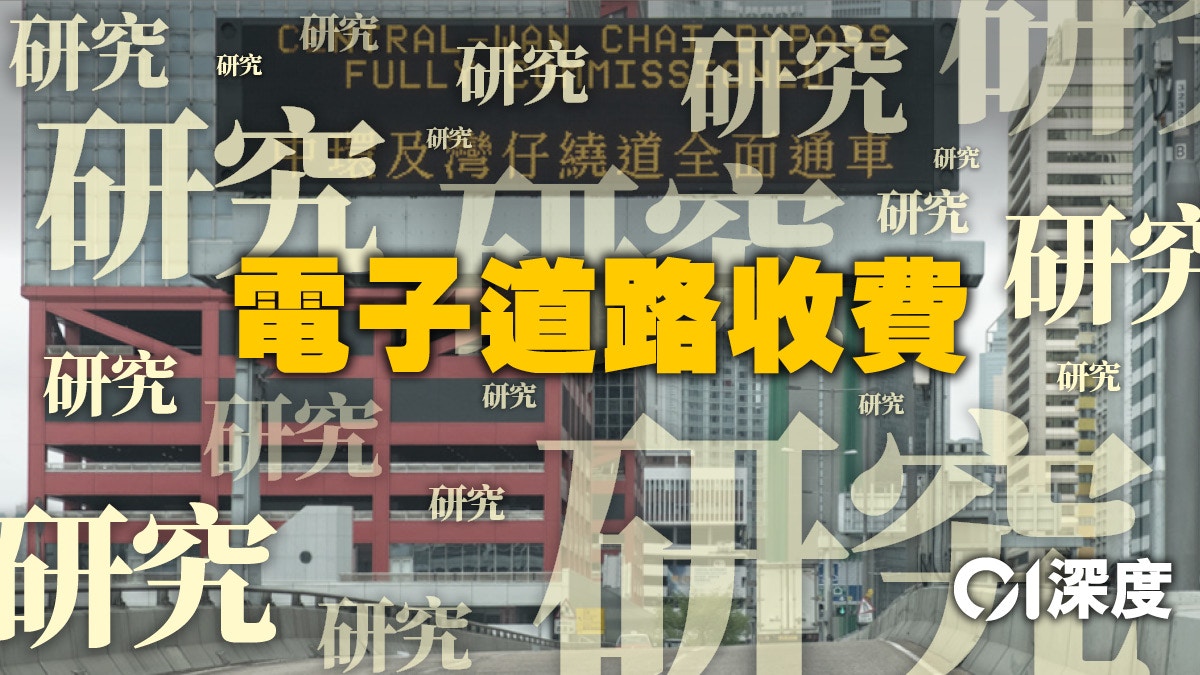In order to solve the problem of traffic congestion in Hong Kong, the Hong Kong government began to discuss the possibility of fully using electronic road pricing as early as 1982. After many studies, it was not until 2015 that the "Central District Electronic Road Pilot Project" was launched. The Central-Wan Chai Bypass was implemented after it was completed, but now the bypass has been completed for two years, and the relevant plan is still missing.
Chief Executive Lam Cheng Yuet-ngor promised in the 2017 election platform that electronic road pricing would be implemented as soon as possible to improve traffic. However, she did not mention the progress when she published the last policy address of her term early last month.
Is this plan unfeasible, or is the government's "procrastination" "breaking" again?
Many Tuen Mun residents are suffering from traffic congestion and complain about frequent traffic congestion on Tuen Mun Highway.
(Profile picture)
A trial run during the colonial period
was shelved due to political and privacy reasons
As early as 1982, Hong Kong had discussed the feasibility of fully using electronic road pricing. The British Hong Kong government subsequently tested a 21-month pilot program in Central in July 1983. About 2,500 vehicles voluntarily participated in the test. There is no actual charge for the process. The vehicles participating in the test must be equipped with an electronic board with identification code on the bottom. When the vehicle passes the toll point, the roadside computer will transmit the identification code of the wheel to the control center to print the monthly statement. one.
The conclusion of the pilot plan at that time was that the entire plan was rated as feasible whether it was technological, administrative or legal.
However, when the "Sino-British Joint Declaration" was signed in Hong Kong in the 1980s, the public was worried that the government would use the electronic toll collection system to monitor citizens' privacy, and the plan was therefore shelved.
Later, the number of private cars increased rapidly. In 1995, the British Hong Kong Government decided to further explore the use of electronic road pricing to alleviate traffic congestion.
In the early days of the reunification, the SAR government spent 75 million to launch an "Electronic Road Pricing Feasibility Study" during which it conducted a two-month field test. The program did not send sensitive information such as driver identities and driving records to the government and service providers.
Although the Transport Department estimated that the system was able to smooth out at least 40% of the urban traffic flow, after the study was completed, Wu Rongkui, then Secretary of the Transport Bureau, voluntarily withdrew the proposal on the grounds that the road tolls were "too severe."
The government’s research results also put forward three key points. First, the growth rate of private cars is not high, and the rationale for implementing electronic road pricing is not sufficient; second, one of the electronic road pricing technologies, global navigation satellites, is under development; third, social needs A broad consensus is required to make the plan successful.
The British Hong Kong government had studied the electronic road pricing system and conducted a pilot project. However, because Hong Kong was returning to the country at that time, the public opposed the plan due to privacy and political considerations, and the plan was shelved.
(AP)
Feasibility study refers to high
government has said No public consensus
It was not until 2006 that the government conducted the "Traffic Congestion Charging Transport Model-Feasibility Study" again, and proposed the "Congestion Levy" for the first time. The "user pays" principle is to charge, and it is also recommended to set up free alternative routes to allow drivers to bypass the toll area.
However, the government later stated that in view of the community’s failure to reach a broad consensus on whether to implement the plan and poor economic conditions at the time, the growth of private cars was lower than expected. The plan is shelved.
By 2014, the Traffic Advisory Committee formulated improvement plans for the problem of urban road congestion, and submitted the "Hong Kong Road Traffic Congestion Research Report" at the end of the same year, again putting forward recommendations for electronic road pricing.
At that time, the TAC also conducted a questionnaire survey on electronic road pricing, collecting opinions from about 6,000 citizens and 3,000 drivers. The results showed that 60% of the respondents supported the implementation of electronic road pricing in busy areas. This shows that the general public has broad consensus on the implementation of the plan. .
However, despite the government’s agreement to the report’s recommendations, in the end, the public’s lack of knowledge on the electronic road pricing technology and operation and the difficulty in reaching a broad public consensus were not implemented immediately.
It was not until the following year that the government finally announced that it would implement the "Electronic Road Pricing Pilot Program" in the Central area, with a three-month period of public consultation and a feasibility study, which is expected to be completed in 2019.
In 2017, Carrie Lam’s first Policy Address during her term of office proposed to “prepare as soon as possible for the implementation of an electronic road pricing pilot program in Central and its adjacent areas”; by the 2018 Policy Address, she once again proposed that it will be held in 2019. In the first half of the year, we consulted stakeholders on the specific plan of the "Electronic Road Tolling Pilot Scheme" and studied the application of the concept of "congestion levy" to the toll levels of toll tunnels and Tsing Ma and Tsing Sha control areas.
However, until this year, the Central-Wan Chai Bypass, which was originally planned to be a toll-free section, has been completed for two years, and the Legislative Council has just passed an amendment to the law on the use of payment discounts. However, the government suddenly "re-exited" and changed the view that the Central District was used for the first experiment. , Saying that after the West Crossing Tunnel's operating rights will be reclaimed in 2023, a "congestion levy" will be introduced in the cross-harbour tunnel, causing the Central District Electronic Road Tolling Scheme to be shelved again. It is also unknown whether the plan will "see the sky again" in the future.
The government launched the "Central District Electronic Road Pilot Project" in 2015. The original plan was to be implemented after the completion of the Central-Wan Chai Bypass. Now that the bypass has been completed for two years, the electronic road pricing plan is still "not seen."
(Photo by Liang Pengwei)
Since "everything is ready",
why not be determined to implement it?
Since 1983, the government has proposed four studies on electronic road pricing plans. Almost every time, the implementation of the plan has been shelved for various "innocent" reasons. However, the feasibility of the plan, the motivation for implementing the plan, and the community's response to the plan are determined. In other words, the shelving of the plan can be described as "unreasonable."
First of all, the government has always said that the plan "has not achieved broad social consensus" or does not understand the technology, so it cannot be implemented rashly.
However, a questionnaire survey conducted by the TAC in 2014 has shown that the public has a high degree of support for the electronic road pricing scheme.
In addition, the Hong Kong Institute of Public Governance also conducted an online survey in April 2019. 64% of the drivers and 63% of the non-drivers surveyed supported the establishment of electronic road pricing, which once again proved that the public has already Broad consensus.
Moreover, if there are members of the public who do not understand the electronic road pricing technology, the government should be responsible for more public promotion and explain the related technology to the public to relieve their incomprehension or doubts, instead of taking no action and saying "the public "I don't know the technology" as an "excus" to shelve the work.
Second, the government pointed out in the second and third feasibility studies that the growth of private cars was lower than expected, and there was no sufficient reason to implement the electronic toll collection plan.
It is undeniable that before 2009, due to the economic downturn caused by the US sub-prime crisis, the growth rate of private cars slowed down briefly, but soon there was an explosive growth. The number of private cars increased from 394,000 to 2018. Of 560,000 vehicles.
Although the growth of private cars has slowed slightly in the past two years due to the anti-amendment case and the new crown virus epidemic, the growth of first-time registered and licensed private parents has returned to an upward trend in March this year.
On the other hand, according to the average speed data of Central in recent years, when the Central-Wan Chai Bypass was completed in 2019, the average speed of the area increased significantly. However, one year after the bypass was completed, the speed of the area showed signs of declining again. Connaught Road Central The speed of the eastbound vehicle dropped from 11.7 kilometers per hour in 2019 to 9.6 kilometers per hour.
From the above data, we can see that the number of vehicles will increase in the future, and even if the Central-Wan Chai Bypass can disperse the traffic flow, it will eventually be saturated. Therefore, it is necessary to implement electronic road pricing in the Central District.
Thirdly, in terms of the feasibility of the plan, the results of the British Hong Kong government’s test in 1983 have shown that the plan is highly feasible. In 1990, Hou Daoguang, an assistant professor at the School of Economics and Finance of the University of Hong Kong, reviewed the effectiveness of the plan and believed that the plan was effective and costly. Lower than building new roads.
On the technical level, the Legislative Council has adopted the use of toll discounts to levy tunnel tolls. The Secretary for Transport and Housing, Chen Fan, also said that the concept of toll discounts can be applied to the Central Electronic Road Toll, but it is necessary to carefully study how the measures should be implemented. .
The busy areas of Hong Kong have been affected by traffic congestion for many years. People often suffer from "traffic congestion", which greatly reduces the quality of life.
If the electronic road pricing scheme is already "all things ready", the only "dongfeng" owed is the government's determination to implement the plan.
The number of vehicles will increase in the future, and even if the Central-Wan Chai Bypass can disperse the traffic flow, it will eventually be saturated. Therefore, it is necessary to implement electronic road pricing in the Central District.
(Photo by Ou Jiale)














